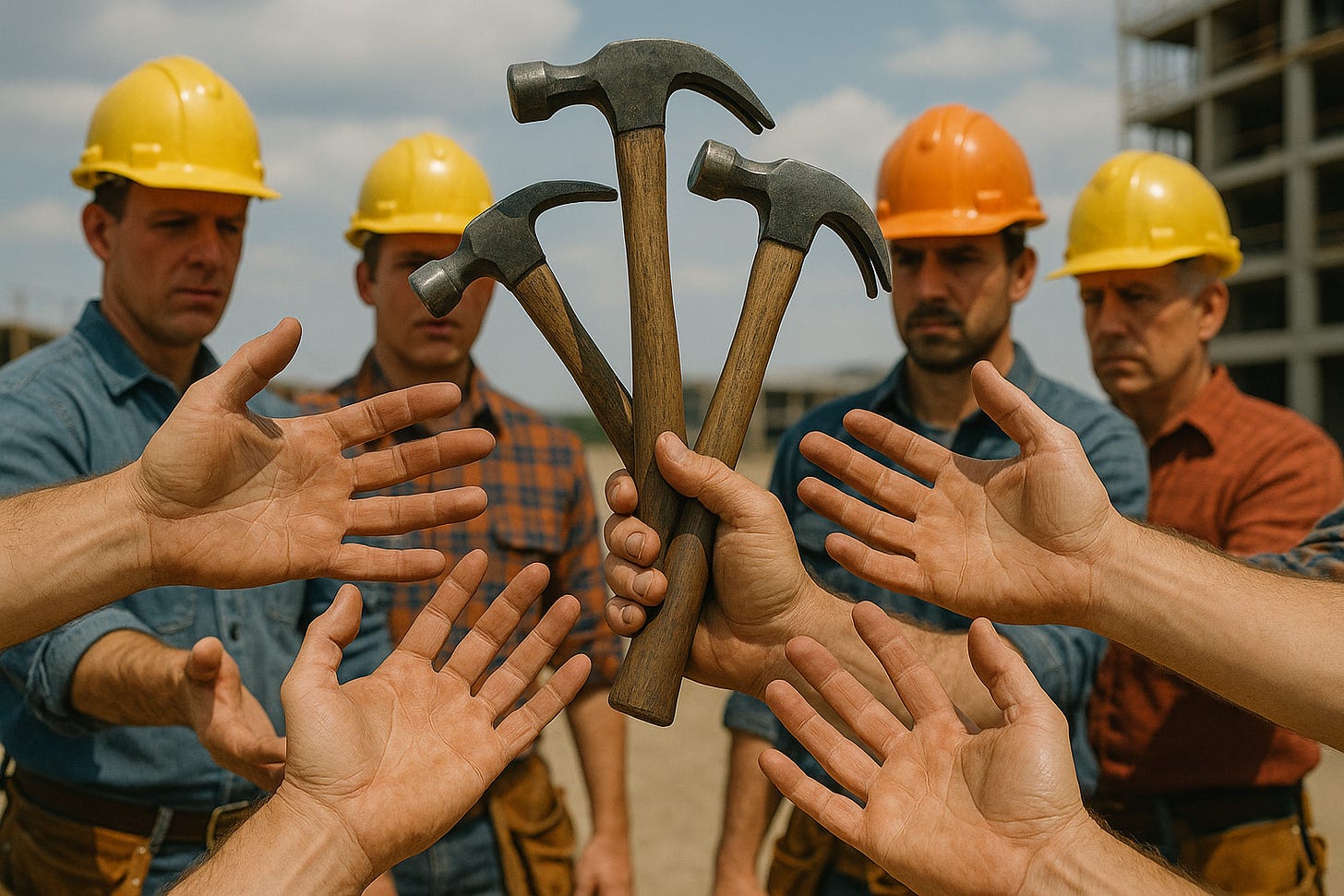Too Many Hands, Not Enough Hammers
What happens when the workforce shows up—and there’s nothing to build?
Back when I was still running framing crews, we had this one job where the permits got pulled halfway through because the city inspector didn’t like the grade of gravel on the laneway. I’m not joking. The gravel. So I had five crews show up the next day, toolbelts on, ready to work. And there was nothing.
They stood around drinking Tim Hortons, arguing about drywall techniques and baseball stats. At one point, one guy—Filippo—started framing an imaginary wall in the parking lot just to stay busy. We were paying tens of thousands a week… for nothing.
That was the first time I truly understood economic stagnation.
What I didn’t realize then is: that little scene in the parking lot? That’s the entire economy right now.
The Workforce Is Here. The Work Is Not.
From construction sites to boardrooms, there are too many hands and not enough hammers.
We’ve got planners without projects, engineers without permits, analysts without deals, trades without trenches, marketers without campaigns. Everyone’s either frozen, delayed, or waiting for someone to say, “You’re good to go.”
And nobody’s saying it.
We’ve built up a workforce ready to go to war, but the battlefield is mud. Developers can’t launch. Cities won’t approve. Lenders won’t lend. Tech can’t pivot fast enough. Governments are still in decision paralysis.
It’s not a recession. It’s a stall. A slow-motion freeze where everyone’s breathing but no one’s moving.
“Just Reskill!” they say.
Sure. Into what exactly?
It used to be that when one sector slowed, others picked up the slack. A site super became a building inspector. A sales rep moved into leasing. A laid-off tech worker joined a startup or found contract work.
But now AI is eating the fallback jobs. Customer service? Gone. Admin? Gone. Entry-level marketing? Replaced by a Canva template and a ChatGPT prompt.
You can’t pivot if every direction is blocked.
So Where Do They All Go?
Some move home. Some get burned out and disappear. Some do contract work until their RRSPs run out. Others start side hustles that make zero dollars but get lots of likes.
A few reinvent themselves. Most just wait.
And then when the cycle turns—when we finally need bodies again—they won’t be there. They’ll be out of province, out of industry, or out of fucks to give.
And suddenly everyone will be shocked:
“We can’t find good people anymore!”
Buddy, you had them. You just didn’t know what to do with them.
Meanwhile, AI’s Not Waiting
AI didn’t get the memo that we’re in a holding pattern. It’s out here automating your analyst, replacing your coordinator, rewriting your leasing copy, and generating investment decks faster than your MBA intern ever could.
And it’s just getting started.
This isn’t sci-fi anymore. It’s not a “future of work” panel at a downtown Sheraton. It’s happening right now, in real estate, in tech, in finance, in legal.
The new rule is simple: Be exceptional, or be replaced.
So What Does Work Look Like Now?
It’s fragmented.
It’s digital.
It’s confused.
And it’s brutally competitive.
Here’s the shift:
Specialists win. Generalists are toast unless they can think like founders.
Trades are safe… for now. You can’t AI a plumber (yet).
Content is currency. Your Substack might get you a job faster than your LinkedIn.
Being “available” doesn’t mean you’re needed. Harsh, but true.
What Should We Do?
If you’re a worker:
Use this idle time like it’s borrowed money. Build something. Learn something. Do something that creates leverage later.
If you’re an employer:
Don’t let your team rot on the bench. If you can’t deploy them, develop them. Train them. Make them dangerous for when the game resumes.
Because this freeze won’t last forever. And when it thaws, you’ll want people who didn’t spend the entire off-season watching reruns of Dragon’s Den and reorganizing their toolboxes.
Final Thought
Too many hands. Not enough hammers.
That’s the story of our time. Not because the hammers don’t exist—but because the system forgot how to swing them.
So we wait.
And when the work comes back—and it will come back—the ones who spent the downtime building themselves will be the ones holding the blueprint. The rest will be stuck on the sidelines, wondering how the hell we got here.








Well - I am a capitalist, as are you, and we should all know that modern economic theory going back to Keynes, was predicated on these upturns and downturns - and the without those downturns - what some call the creative destruction of capitiaalism - we have another much more serious problem - like now - when our entire economy has been subverted into a real estate machine. The wasted resources that results is built into our economic management - and one might, and should, question how apt that is. But the alternative, which you are inherently suggesting, of government taking over - will produce even more horrendous results, in time. Need you be reminded of China or the USSR as prime examples. And lets be crystal clear - more government subsidies for Real Estate will only exacerbate the immense problem we already have. Time to find work in the mines the mills and the factories. The thoughts are intruging. Keep thinking, keep writing.
Another EXCELLENT post! Thank you. I agree with your analysis (which I appreciate how you broke it down). My only point is, this downturn is supposed to last for 5 years. So, practically speaking: how does a person and/or business go that long on the sidelines. I mean, you're 5 years older potentially before the turnaround happens. Idk, just my thoughts.